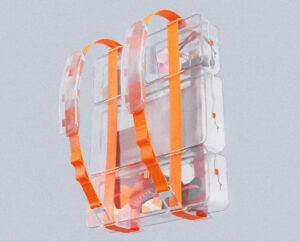
In an age where our lives oscillate between hybrid work, spontaneous movement, and perpetual multitasking, the humble backpack has become more than a vessel—it is our mobile base camp. And yet, for all its ubiquity, the backpack has remained largely unchanged for decades: a black hole of belongings, where cables tangle, snacks squash, and essentials routinely vanish in fabric folds. Designer Maria Olhovnikova proposes a radical redesign of this everyday object—not by adding more features, but by subtracting the chaos.
Her transparent modular backpack concept is a provocative and poetic response to a modern condition: the need for efficiency without excess, visibility without exposure, and movement without mess. In a world that demands agility, this design offers visual clarity, compartmentalized order, and aesthetic balance, reimagining not just how we carry things, but how we navigate the day.
The Ritual of the Pack: Chaos as a Starting Point
Every backpack user knows the drill: keys fall to the bottom, notebooks warp under the weight of protein bars, and charging cables develop an uncanny ability to entwine with whatever they find. It’s the kind of daily annoyance that seems too minor to complain about, yet too persistent to ignore. The act of packing is often a performance of hope over logic—a ritual that prioritizes capacity over coherence.
Maria Olhovnikova’s approach begins here, with the acknowledgment that traditional bag design is fundamentally opaque—not just physically, but functionally. Her intervention is less about “innovation” in the Silicon Valley sense and more about clarifying an overlooked human experience. If life is increasingly modular—shifting between workspaces, workouts, cafés, and commutes—shouldn’t our gear be too?
Her concept dares to ask a simple question: what if you could see everything you carry, instantly?
Visibility as Empowerment: The Power of Transparency
The first, and most striking, element of Olhovnikova’s design is its transparent exterior. Constructed from semi-rigid, lightly frosted plastic or silicone-derived composite materials, the bag presents its contents without displaying them like a store window. It offers a ghosted translucency—enough to identify items, but not enough to violate privacy.
This design choice is about more than visibility—it’s about time, agency, and calm. No more rummaging or repacking. In a single glance, the wearer knows what’s missing, what’s unnecessary, and what’s ready to go. The transparency collapses the time gap between decision and departure, transforming the backpack from a passive carrier into an active tool for organization.
In design theory, transparency is often framed as a metaphor for trust. Here, it becomes a metaphor for personal alignment: seeing your life clearly, divided with intention.
Modular Architecture: Compartmentalization Without Clutter
But visibility is only half the story. The true genius of the concept lies in its modular internal structure. Rather than a single cavernous space—or worse, a token sleeve for laptops—the backpack is built around a series of stackable, removable compartments, each designed for a specific category of gear: one for tech accessories, one for lunch or gym clothes, another for documents or reading materials.
These modules snap or slide into place using an internal frame rail system, allowing users to customize the bag’s internal logic based on their day. Heading to the office? Snap in the laptop and paper trays. Gym after work? Add the breathable mesh box for your gear. Traveling light? Strip it back to just two compartments.
This flexibility turns the bag into a spatial editor—a way to design your day, spatially and symbolically. It acknowledges that not all tasks deserve equal weight, and not every item needs to follow you everywhere. The modular system encourages minimalism by making its benefits obvious: less bulk, more clarity, no waste.
Form Language: Minimal, Urban, Unapologetically Forward
Visually, the backpack is a study in streamlined futurism. Its shape recalls the contours of aviation or medical equipment—not sterile, but deliberate, tuned to the frequency of modern infrastructure. The semi-rigid body gives it structural presence, so it stands upright even when partially packed, while its translucent panels catch light with subtle refraction, making it architectural rather than ornamental.
The exterior features are minimal by design. A discreet handle. Adjustable straps with industrial-style sliders. One low-profile side pocket for immediate-grab items like cards or keys. The backpack reads like an object of function, not fashion—but in that, it gains fashion relevance. It echoes the design ethos of brands like ACRONYM, Issey Miyake’s Homme Plissé, or even Muji—form-driven, practical, and almost utopian in simplicity.
Maria Olhovnikova’s concept is not a design for hype. It’s a design for people who want to move through cities with less friction and more intention.
Designing for Contemporary Flow: Movement as Philosophy
The modern day is no longer divided into distinct “work hours” and “personal time.” We toggle constantly—between roles, locations, and mindsets. Olhovnikova’s bag understands this as a baseline condition. It is not designed for static storage; it is designed for flow.
This has cultural and psychological implications. A transparent, modular backpack invites you to rethink what you carry, and why. It elevates the act of packing into a form of mindful curation. Do I really need this item today? Is there a way to simplify my load? The bag becomes a partner in this reflection, a visual index of your intentions.
Moreover, it subtly resists the digital chaos of notification-heavy life. By grounding your physical items in clarity and structure, it offers a counterbalance to the algorithmic entropy of daily experience. It says: start here. What matters physically? What moves with you? What stays behind?
Potential Impact: Beyond the Backpack
Though still a concept, the potential applications of this design are vast. Commuters would benefit from its clarity and compartmental logic. Students could organize gear by class or subject. Athletes and gym-goers could isolate sweaty gear from clean items without fuss. Even parents could find value in the intuitive visibility of daily essentials.
It also opens doors for circular design thinking. With removable compartments, components could be sold, recycled, or upgraded independently. Break a clasp? Replace the module. Need a new shape for travel? Swap in a different insert. This aligns with the modular sustainability principles gaining traction in both fashion and tech hardware.
In a market oversaturated with overbuilt bags—offering more pockets than one can fill—Olhovnikova’s concept offers something radical: clarity as a service.
Gender-Neutral, Age-Agnostic: Design That Transcends Demographics
Another merit of this backpack concept is its universal appeal. It is not pinked for women or militarized for men. It does not presume age, location, or occupation. Instead, it offers a neutral platform—a shell that can be filled with any life.
This neutrality is central to its elegance. The bag doesn’t compete with personal style; it complements any identity by refusing to impose one. It’s not normcore. It’s not techwear. It’s not vintage. It’s simply clear—functionally and philosophically.
In that, it echoes the best of 21st-century design: where form supports use, where objects dissolve into infrastructure, and where ownership becomes a means of organizing self, not signaling status.
The Backpack Reimagined as a Mirror of Motion
Maria Olhovnikova’s transparent modular backpack does not just reimagine how we carry our things. It reimagines how we engage with the tempo of our days. Through visibility, modularity, and material restraint, it proposes a new form of daily self-governance—a way to navigate modern life not with more gadgets, but with better tools.
In the end, the concept is not about the bag itself. It’s about what it enables: ease, clarity, agency. In the daily rituals of movement—whether from home to office, café to gym, meeting to meditation—this backpack becomes not just a companion, but a quiet collaborator.
And in that silence, we hear a message louder than any brand logo: know what you carry, and why.
No comments yet.









